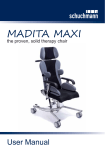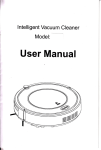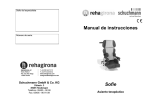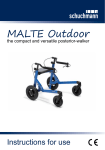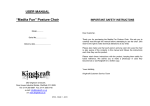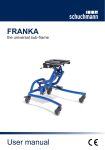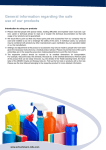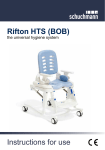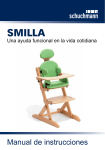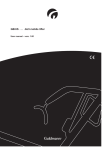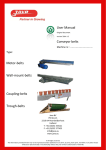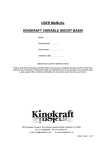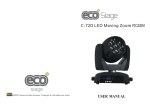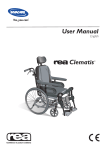Download MADITA-FUN
Transcript
MADITA-FUN Posture Chair User Manual Dear Customer, Thank you for purchasing the Madita Fun Posture Chair. We advise you to read through this manual carefully before attempting to use the chair. (We reserve the right to make technical alterations at any time) Please also make sure that each person and any carer who uses the chair is also aware of the contents in this manual and follows the instructions each time they use the product. Please retain these instructions with the product, keeping them safely for future reference. We advise you to make a photocopy in case they become lost or ask us for a further copy. Yours faithfully, Schuchmann Team Contents Contents Page 1. General Information 2 2. Overview / component parts 2 3. Operation of the standard product 3.1 Locking the castors 3.2 Seat height 3.3 Seat angle 3.4 Inclined back rest 3.5 Seat depth 3.6 Back rest height 3.7 Knee angle 3.8 Foot support height 3.9 Arm rests 3 3 4 4 4 5 5 5 6 4. Use of the accessories 4.1 Head Support 4.2 Side bolsters 4.3 Side bolster additional info 4.4 Hip bolsters (seat width) 4.5 Table 4.6 Knee abduction wedge 6 7 7 7 8 8 5. Cleaning and maintenance 9 6. Technical data 9 7. Guarantee details 9 MADITA-FUN - Modification status C - Issued 11.2010 1 General Information / Overview 1. General information The Madita Fun Posture Chair is intended for use by children and young persons who are unable to sit or stand unaided. Attention: The product must not be used without supervision The product must only be used on even or solid ground The product must not be used to transport people In order to assist with the transfer of the user into and out of the product, the Carer must stand at the side of the chair and hold the seat support. This ensures that all moving parts e.g. height adjustment remains unaltered. 2. Overview / component parts Important information! When adjusting the locking screws or nuts, please use the hexagonal key or spanner supplied with the chair. These should be located with the user manual attached to the back of the chair. An example of the Madita Fun Posture Chair: Head Support Back Rest Side Bolsters Base Frame Backrest Angle Adjustment Arm Rests Hip Bolsters Seat Rear Castors with Brakes Foot Pedel for Height Adjustment 2 Front Castor Foot Support Operation of the standard product 3.1 Locking the castors The Posture Chair is parked by locking the two rear castors. Foot operation of the brakes: Releasing the brakes: Warning: The brakes only operate correctly on even surfaces! 3.2 Seat height adjustment Seat height adjustment is assisted by a gas spring. To raise the seat height, operate the foot pedal (arrowed). With slight assistance, the seat will raise. To lower the seat, depress the pedal and at the same time push down on the seat. The foot pedal can also be locked in position, to prevent unwanted movement, by means of the locking pin which is to be found on the inner side of the foot pedal. Turn the locking pin until it engages (slight movement of the foot pedal will help it to engage). To unlock the pin, pull it outwards and turn through a quarter turn. 3 Operation of the standard product 3.3 Seat angle adjustment In order to adjust the seat angle, the hand release lever should be pushed downwards. The seat unit can then be moved into the ‘Active’ or ‘Passive’ position. The locking bracket should be hinged down to avoid the lever being unintentionally adjusted when in use. Hand Release Lever: 3.4 Inclined back rest The angle of the back rest can be adjusted by operating the clamp handle (see arrow). When adjusted, retighten the clamp handle. 3.5 Seat Depth Adjustment of the seat depth is done by loosening the two socket head bolts (see arrow) which are on the side of the chair. When the seat is in the desired position, the bolts should be retightened. Caution! After making all adjustments, tighten all the screws firmly again! 4 Operation of the standard product 3.6 Back rest height To adjust the height of the back rest, the two locking wheels behind the back rest (see arrows) should be loosened. When the back rest is in the desired position, the locking wheels should be retightened. 3.7 Knee angle adjustment The knee angle adjustment has a ratchet mechanism which allows for adjustment in small steps. To adjust the angle, both locking wheels (see arrow) must be loosened. When the required position is achieved, the locking wheels should be retightened. 3.8 Foot support height The foot support height can be adjusted. To do this, loosen both socket head screws (see arrows) on the rear side of the foot support. When the required position is reached, the screws should be retightened. On delivery, size 0 has a lower leg length adjustment rage from 20 cm to 24 cm. To get a lower leg length from 15 cm to 20 cm, the innertubes have to be trimed. To do that, the setscrew must be loosened and both press bottons have to be pushed. Now the foot rest can be removed and the inner tubes of the lower foot rest part must be trimed 4 cm. Insert the press buttons in the innertubes and reassemble the foot rest. Caution! After making all adjustments, tighten all the screws firmly again! 5 Operation of the standard product / Use of accessories 3.9 Arm rests Arm rest height adjustment A The two arm rests are adjusted by loosening the locking wheels (B) on the arm rests left and right. When in the required position, the locking wheels should be retightened. B Arm rest angle adjustment The angle of the arm rests can be adjusted. This is very useful when a table is being used. To adjust the angle, loosen the top locking handle (A) at the side of the arm rest. When in the required position, retighten the locking wheel. Arm rest width adjustment The width adjustment is done by loosening the locking nuts (C) which can be found underneath the seat surface. When in the required position, the locking nuts should be retightened. C 4. Use of accessories A 4.1 Head Support The angle and height of the head rest can be adjusted. To make the adjustment, loosen the bolts (B) in the articulated arms of the head support holder. When adjustment is complete, retighten the bolts. To adjust the height, loosen the two locking wheels (A). When adjustment is complete, retighten the wheels. Caution! After making all adjustments, tighten all the screws firmly again! 6 B Use of accessories 4.2 Side bolsters To adjust the width, loosen and remove the two nuts (see arrows) on the back of the back rest. The height is adjusted by loosening the nuts and bolts at the required height in the slotted holes (see arrows) in the backrest plate. 4.3 Lateral foldable Side bolsters To fold the side bolster laterally, the red press button on the top side of the link, must be pushed. Now the side bolster can be pivoted laterally. 4.4 Hip bolsters (seat width) Width / angle adjustment (seat width) After loosening the cylindrical head bolts (A), the angle and width of the hip bolster can be adjusted (seat width). A Height adjustment The height of the bolsters is adjusted by loosening the two bolts (B). When adjustment is complete, the bolts should be retightened. B Caution! After making all adjustments, tighten all the screws firmly again! 7 Use of accessories 4.5 Use of table Table height This is adjusted by means of the arm rests. Depth adjustment To alter the distance of the table form the user, the winged locking nuts (see arrow) should be loosened. Retighten the wing nuts after adjustment. Folding To fold the table, for example when the user is being positioned in the chair, it is simply folded upwards, to one side. 4.6 Knee abduction wedge Height adjustment The height is adjusted by loosening the wing nut (see arrow) on the abduction wedge. The wing should be retightened following adjustment. Depth adjustment The depth is adjusted by loosening the nuts (see arrows) which are found under the seat. Retighten the two nuts following adjustment. Caution! After making all adjustments, tighten all the screws firmly again! 8 Cleaning and maintenance / Technical Data / Guarantee 5. Cleaning and maintenance The Posture Chair is designed to be relatively maintenance free. All parts are corrosion resistant. However under unfavourable conditions some slight rusting may occur. If this happens, it can be easily removed by simply wiping with polish and a soft cloth. It is recommended that following a long period of use, all nuts and bolts are checked for tightness. Like every technical product, the chair requires regular inspection. Check the unit frequently for tears, breakage, holes or lost parts and/or non functioning parts. Remove the chair form normal use when it is clear it is not functioning correctly or safely. 6. Technical Data Dimensions in cm Gr. 0 Gr. 1 Gr. 2 Seat depth 15 - 24 21 - 30 30 – 42 Seat width 16 - 30 16 - 30 26 - 38 Height of low backrest 30 30 40 Height of high backrest 38 38 48 Max. adjustable backrest height 45 45 55 Seat height 25 - 60 25 - 60 25 - 60 Lower leg length 15 - 24 21 - 31 28 - 45 56 56 66 Total witdh Total length 65 65 75 Seat angle (-) 8° - 30° (-) 8° - 30° (-) 8° - 30° Backrest angle (-) 5° - 25° (-) 5° - 25° (-) 5° - 25° Max. load (kg) 30 30 50 Weight of chair (kg) 20 20 24 Castors: 2 x double castors 2 x locking double castors This product conforms to the following guideline: 7. 93/42/EWG for medical products Guarantee The Madita Fun Posture Chair, with its’ accessories, are guaranteed in the UK for a period of 12 months from the date of delivery against defects arising from faulty material, inferior workmanship or construction. The result of incorrect handling of the unit shall not be covered by the guarantee. In line with the company’s policy of continual product improvement, we reserve the right to carry out improvements to the specification without notice. 9 Distributor: Serial number: schuchmann GmbH & Co. KG Dütestraße 3 · 49205 Hasbergen · Fon +49 (0)5405/909-0 · Fax +49 (0)5405/909-109 [email protected] · www.schuchmann-reha.de












